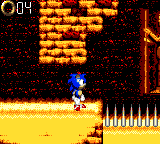Sonic Blast
- This article is about the Game Gear game. For the Sega Genesis/Sega Saturn/PC game, see Sonic 3D Blast.
| Sonic Blast | |
|---|---|
| Developer(s) | Sega |
| Publisher(s) | Sega |
| Designer(s) | Toshiaki Araki (Programming), Fumikazu Sugawara (Design), Kojiro Mikusa (Sound) |
| Platform(s) | Game Gear; Sega Master System (Brazil Only) |
| Release | |
| Genre(s) | Platform game |
| Mode(s) | Single player |

Sonic Blast is a video game in the Sonic the Hedgehog series, developed and published Sega for the Sega Game Gear. Alternatively it is known as G Sonic in Japan. It was released in November of 1996 for both North American and European markets. A Japanese release followed later that year on December 13. The game was also ported to the Sega Master System. Sonic Blast was later compiled with other Sonic titles in Sonic Mega Collection Plus and Sonic Adventure DX, and a demo of its ending can be unlocked in Sonic Gems Collection.
Gameplay
Unlike it's pseudo-3D counterpart, Sonic Blast for Game Gear was a side-scrolling run and jump platform game. It was among the last new Sonic the Hedgehog games released for the Sega handheld, and sported some of the most advanced features of the 8-bit series.
The two playable characters in the game are Sonic the Hedgehog and Knuckles the Echidna. The object of the game is to collect five Chaos Emeralds, in stages visually similar to the Sonic the Hedgehog 3 special stages, but instead require Sonic and Knuckles to collect rings as in Sonic the Hedgehog 2's special stages. Emeralds can only be obtained in the second act of each level. Finishing a special stage in the first act will gain the player an extra life instead. Similar to Sonic 3, special stages are entered through large rings hidden in the regular stages. Also, when you get hit by enemies, you only lose a few rings, not all of them.
Zones
- Green Hill Zone: Has nothing in common with the classic zone of Sonic the Hedgehog except the tropical theme of the lay-out. This zone is rather easy and designed to get the player started with the basics of the game. Eggman attacks with a spikey boomerang.
- Yellow Desert Zone: A desert zone that recalls Sandopolis from Sonic & Knuckles. Yellow Desert Zone takes place in- and outside and outside a tomb filled with sharp rows of spikes. Eggman attacks as a floating warrior with a spear.
- Red Volcano Zone: This steaming lava mountain has the spin dash lifts of Lava Reef Zone. Eggman pogos around and shoots boulders at Sonic and Knuckles.
- Blue Marine Zone: An flooded labyrinth of warp pipes and water currents. Eggman is fought underwater, as he shoots arrows at Sonic and Knuckles. If one hits the ground, an air bubble comes out.
- Silver Castle Zone: Eggman's factory is a maze of warps mostly reminiscent of Scrap Brain Zone. Teleports are scattered throughout the stage and spiked walls chase the heroes. Eggman attacks with two different machines, but the player has to get all the Chaos Emeralds to fight the second one.
Graphics
A prominent feature of this game was its rendered graphics, which had become popular in Nintendo's 16-bit hit Donkey Kong Country (also known as Super Donkey Kong). The rendered graphics give the game a more advanced look than most other 8-bit games. The character graphics also took up a big portion of the screen.
External links
- Sonic Blast at MobyGames
- Sonic Blast at Green Hill Zone - contains info, screenshots, a basic walkthrough and comparison with available ports.
